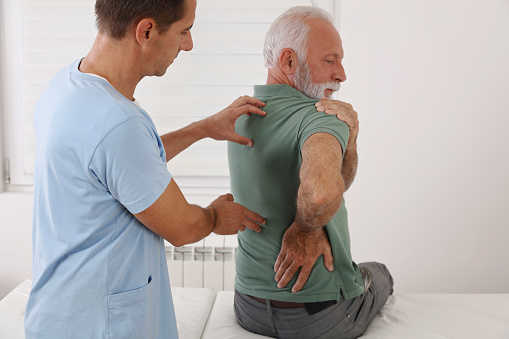Spinal stenosis is basically a fancy word for when your spinal canal narrows. As a result, there’s not enough room, and you may experience pressure on the spinal nerves. It can affect either your neck or lower back.
General Information
Wear and tear will lead to changes in the spinal that cause it to narrow. It’s often the result of arthritis.
In some cases, it doesn’t cause any pain. However, in other cases, symptoms will arise gradually and worsen over time. For instance, you may have pain in your lower back. It might lead to pain and cramping that extends down your legs as well. You may particularly notice these symptoms when you stand or walk for a prolonged time.
The symptoms, for some people, will get better when they sit or bend forward, as a result of pressure easing on the nerves.
Spinal stenosis can affect your neck. When this occurs, you may notice you have numbness in the area. Neck pain is also possible. The symptoms can extend and affect the arm as well, causing you to have tingling or weakness in your leg, foot, arm, or hand.
This condition can affect your ability to walk and may impact your bladder or bowels.
Causes of Spinal Stenosis
You could be born with a smaller-than-average spinal canal, which will then place pressure on the nerves. This isn’t the norm, though. Spinal stenosis tends to occur over time when something limits the amount of space within the spine. For instance, osteoarthritis arises from wear and tear. In some cases, it’ll cause extra bone growth to occur on the spine. The bone spur then places pressure on the spinal canal.
A disc herniation could also lead to your spinal canal decreasing in size. The discs are located in between your spinal bones. Their purpose is to reduce shock and provide movement. The discs have a gelatinous substance inside of them and collagen fibers coating them. Sometimes, the outer layer of collagen fibers tears, and the gel-like substance on the inside leaks out. Having thick ligaments or sustaining a spinal injury could also lead to this condition.
How Chiropractic Care Helps
Although you’ll need to complete your medical history report and talk to your chiropractor about your condition and symptoms, part of your appointment often consists of having X-rays taken. These show the changes in the spinal that are causing the spinal canal to become smaller.
After a better understanding of what’s causing your pain and discomfort and if spinal stenosis is occurring, your practitioner will determine the appropriate course of action for you. If it is spinal stenosis, our chiropractor will want to target the cause, whether it be wear and tear or a herniated disc.
Your treatment may consist of our practitioner giving you spinal adjustments. During these treatments, our chiropractor will move the vertebrae in the spine so they align with the discs. As a result, it’ll take pressure off the sensitive discs. This is particularly beneficial if you have a herniated disc.
Another possible option for treatment could be spinal decompression. With this treatment, our practitioner will take pressure off the spine by gently pulling your spine in opposing directions.
Our practitioner can help with your spinal stenosis pain through exercise therapy. With this treatment, our chiropractor guides you through exercises that gently stretch the spine. Gradually, they increase in difficulty over time as you improve.
At Premier Chiropractic Center, serving Bessemer, AL, and the surrounding region, we can help you if you have spinal stenosis. This is the case even if you have an underlying condition that can’t be corrected and your spinal stenosis is permanent. All the care we provide if you have spinal stenosis is natural and works with your body.
Book an appointment today by calling 205-519-4024. You may also use our online appointment booking tool.

Recent Comments